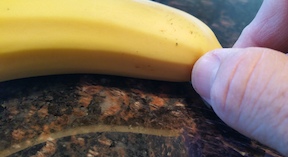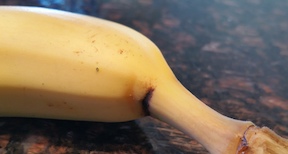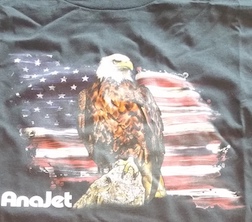Learning from Le Carre, Scoring a Banana
No Snickering, Please
Yes, I'm about to use the words "President Trump" and "intelligence" in the same sentence. In fact I just did. Sounds like politics, I know, a subject I've steadfastly avoided in the decade-plus of this blog. Permit me to avoid it some more. The "intelligence" to which I'm referring is the information about adversaries (and friends) that is routinely collected by our CIA and other agencies, and those of our allies.
It seems that a serious blunder was committed in the White House. The President disclosed, and the press "leaked" a factoid, that can be summed up thus:
- The United States relied and continues to rely on Israeli intelligence in the fight against ISIS.
- An Israeli asset in a particular city in Syria gave us valuable intelligence about a specific ISIS operation or capability to make laptop computers explode in aircraft.
- We told this to high Russian officials, giving not just the information about the laptops, but, impliedly, where it was obtained and from whom we got it.
Agreeing, as I'm sure we all do, that's it's a bad idea to expose human intelligence sources, just how bad was this breach? Very bad indeed if it led to the asset (human being) in Syria which compromised his or her effectiveness, possibly by death. Not so bad if the "leak" was insufficient to pin down just how and from whom we obtained the information. And, judging from the fuss made over the purported disclosure, a positive intelligence boon and triumph if it led to suspicion and discord among the ranks of ISIS, with the concomitant loss of effectiveness among their bomb squad.
Which is it?
Did I Mention Le Carre?
Yes, I did, a number of times, notably in the introduction to this blog eleven-plus years ago. Le Carre wrote a trilogy beginning with Tinker Tailor Soldier Spy (ex-Mayor Mike Bloomberg's favorite novel, and possibly mine) and ending with Smiley's People. From reading Le Carre, whose pre-auctorial career was spy, we learn from these books and others of his how intelligence organizations really work. It involves, unsurprisingly, lies, misdirection, treachery, and ambivalence. Let's look at some opportunities for these in the Trump "leaks."
Did Trump tell the "truth"? Many would argue that he is not exactly a subtle man, and his notorious blurtations on Twitter would seem to affirm that assessment. But as a skilled negotiator, he must be used to keeping some information in reserve. Perhaps it was suggested to him that he misstate the exact location whence the information was elicited. Same with the source of the information. Was it really the Israelis? Of course everyone knows that intelligence is shared with Israel, so whether true or not, it's hardly a revelation.
Was Trump told the "truth"? If I were president, I would tell my briefers to withhold sensitive source information so I couldn't accidentally disclose it. Perhaps Trump made that request, or perhaps, after consideration, the briefers made that decision on his behalf.
So, was the leak true? Or did the enemy hear from us lies or misdirection, carefully calculated to obfuscate the real source of the information? I don't know and, better, they don't know. Even if it was completely accidental and accurate, the enemy will suspect that it wasn't, and enjoy the same sort of indecision either way. Again, at best, it will cause them to distrust themselves.
The reason I like Le Carre so much is that the subject of spying and intelligence is endlessly fascinating in the human dimension. Although nature can be subtle, and electrons in their quantum manifestations can be in multiple locations simultaneously, I have never know an electron (well, many) to be deliberately mendacious. Of course, we're still learning about them.
Scoring a Banana
Long after President Trump has left office, and long, long after this intelligence issue has joined the pile of detritus politics is casting off daily, mankind, if not necessarily this blogging exemplar thereof, will be eating bananas for breakfast. It has been my practice for many years to consume a semi-banana every morning to fortify me for physical activity during the day. (More information, possibly "TMI," will be found in this recent blog.) As you probably know, bananas are protected by an inedible integument called a "peel." In the process of consuming my semi-banana, especially the initial increment, I have found that my normal method of removing the peel**—forcefully grabbing the attachment end and pulling—occasionally results in minor damage to the fruit within due to improper distribution of stress. I have found that by (Fig. 1) scoring the banana near the attachment end with my thumbnail results in concentrating the stress in the peel at the proper location to facilitate its removal (Fig.2).
 |
 |
| Figure 1: Scoring a banana with thumbnail | Figure 2: Stress is concentrated at the score mark, enabling peeling without damage to the underlying fruit |


